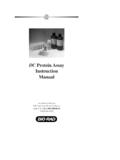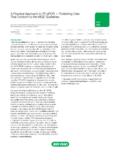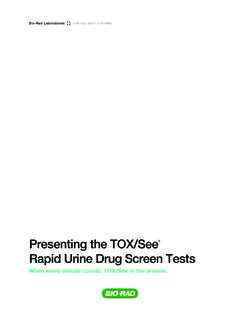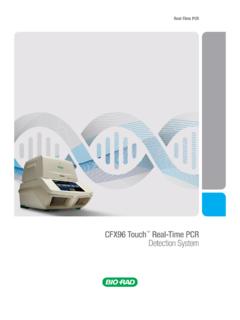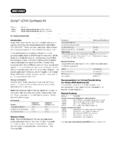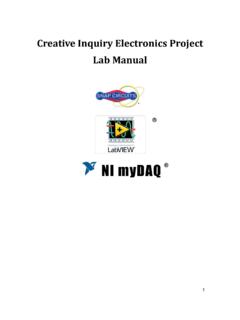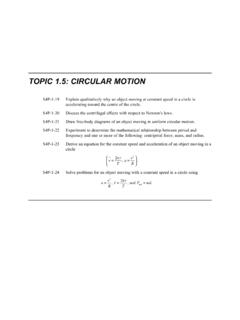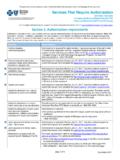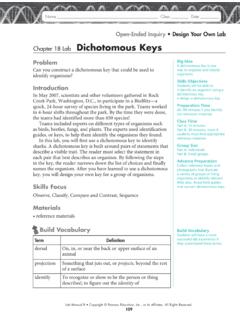Transcription of Crime Scene Investigator PCR Basics Kit - Bio-Rad …
1 Crime Scene InvestigatorPCR Basics KitCatalog # : Kit contains temperature-sensitive reagents. Open immediately upon arrival and store components at 20 C or at 4 C as technical service, call your local Bio-Rad office or, in the , call 1-800-424-6723 Duplication of any part of this document is permitted for classroom use visit to access our selection of language translations for Biotechnology Explorer kit Explorer Crime Scene Investigator PCR Basics KitThis curriculum was developed in collaboration with Dr. Linda Strausbaugh, Director of theCenter for Applied Genetics and Technology at the University of Connecticut-Storrs. ThisCrime Scene Investigator PCR Basics kit allows students to conduct state-of-the-art DNA pro-filing techniques and to develop an understanding of how these techniques are performed inreal-world forensic science labs.
2 Bio-Rad is grateful for Dr. Strausbaugh s guidance and can DNA evidence solve crimes?DNA profiling is the use of molecular genetic methodsto determine the exact genotype of a DNA sample to distinguish one human being fromanother. This powerful tool is now routinely used around the world for investigations of crimescenes, missing persons, mass disasters, human rights violations, and paternity scenes often contain biological evidence (such as blood, semen, hairs, saliva, bones,pieces of skin) from which DNA can be extracted. If the DNA profile obtained from evidencediscovered at the Scene of a Crime matches the DNA profile of a suspect, the individual isincluded as a potentially guilty person; if the two DNA profiles do not match, the individual isexcluded from the suspect pool. What kinds of human DNA sequences are used in Crime Scene investigations?
3 Thereare ~3 billion bases in the human genetic blueprint greater than do not vary amonghuman beings. However, a small percentage of the human DNA sequence (< ) does differ, and these are the polymorphic("many forms") sequences used in forensic universal agreement, the DNA sequences used for forensic typing are "anonymous"; thatis, they are derived from regions of our chromosomes (also called loci) that do not control anyknown traits and have no known DNA sequences used in forensic DNA profiling are non-coding regions that contain segments of short tandem repeatsor STRs. STRs are very short DNA sequences that arerepeated in direct head-to-tail fashion. The example below (Figure 1) shows a locus known asTH01) actually used in forensic DNA profiling; the DNA sequence at this locus contains fourrepeats of [TCAT].
4 For the TH01 STR locus, there are many alternate polymorphic forms (alleles) that differ fromeach other by the number of [TCAT] repeats present in the sequence. Although more than 20different alleles of TH01 have been discovered in people worldwide, each of us still has onlytwo of these, one inherited from our mother and one inherited from our A s DNA type for the TH01 locus is (5 3) Suspect B s DNA type for TH01 locus is (6 10)C C C A A A5*C C C A A A 6*C C C A A A3* C C C A A A 10** Number of [TCAT] repeatsFig. 1. Two sample genotypes at the TH01 are STR alleles detected?The key to DNA profiling is amplification of the copies presentin the small amounts of evidentiary DNA by polymerase chain reaction (PCR).
5 Usingprimers specific to the DNA sequences on either side of the STR, billions of copies of each ofthe two original TH01 alleles in any one person's DNA type are synthesized in the copies contain the same number of STRs present in the original DNA copies and canbe separated by size using agarose gel electrophoresis. By comparison with size standardsthat correspond to the known sizes of TH01 alleles, the sizes of the amplified copies can bedetermined. This kit allows students to simulate genotyping at a locus as commonly used in forensic typing. In real Crime Scene applications, DNA profiling is performed at a number of differentloci to improve the power of discriminationof the testing. In simple terms, the power of discrimination is the ability of the typing to discriminate between different individuals.
6 As anexample, one locus may be able to tell the difference between one out of 1,000 people,whereas two loci can discriminate between one out of 10,000 people. The larger the numberof loci typed, the more powerful the ability to the DNA profiling at the simulated BXP007 locus in the Crime Scene InvestigatorPCR Basics kit, the teacher has the option of an additional lesson that simulates the use ofthe 13 core CODIS (Combined DNA Index System) loci used in actual casework. This simpleexercise demonstrates the concept of increasing power of discrimination with increasing numbers of loci typed, and illustrates how even siblings can be identified by DNA student team will generate their own set of genotypes, collect and record data on aworksheet, and perform simple statistical Strategy Guided inquiry - based Investigation The intent of this curriculum is to guide students through the thought process involved in alaboratory- based scientific investigation.
7 Students will learn about PCR, gel electrophoresis,genotyping, and genotype matching while asking the question "How can a tiny amount ofgenetic material (DNA) be used to identify one person out of a billion?" In the context of acrime Scene case study scenario, this activity could raise a host of questions such as "Why isthis important?"The students' focus is not so much on the answer or result, but on how the result wasobtained and substantiated by careful observation and analysis of their data. Students whoengage in Biotechnology Explorer activities develop a positive sense of their ability to employthe scientific method to solve problems. Thought provoking questions embedded in the student manual are designed to maximize students' involvement in the laboratory. Studentinvolvement in this process results in an increased understanding of the value of approachinga scientific challenge in an organized and logical fashion.
8 This manual can be downloaded from the Biotechnology Explorer website. Visit us on theweb at , or call us in the US at 1-800-4 BIORAD (1-800-424-6723).We continually strive to evolve and improve our curricula and products. We welcome yoursuggestions and ideas! Biotechnology Explorer ProgramLife Science GroupBio-Rad LaboratoriesHercules, CA context. Reinforce learning. Stay scientific discoveries and technologiescreate more content for you to teach,but not more time. BiotechnologyExplorer kits help you teach moreeffectively by integrating multiplecore content subjects into a single lab. Connect conceptswith techniques and putthem into context withreal-world SceneInvestigatorPCR BasicsKitEnvironmentaland HealthScience Population genetics Genetic screening Genetic databases Role, place, limits of scienceand technology Privacy of information issues Eukaryotic cell structureand organization Tissue types and biologicalsampling Use of PCR and gel electrophoresisfor DNA profiling Use of experimental controls Interpretation of experimental results Use of forensic evidence in the courts Mendelian genetics Polymorphic loci and multiple alleles Genetics of noncoding DNA Short tandem repeats (STRs) Genetic identity Structure and function of the human genome DNA replication and thepolymerase chain reaction (PCR)
9 Chemical properties of biologicalmolecules DNA structure and function Chemistry of electrophoresis Genetic diversity andindividual identification Allele frequencies inpopulations Statistics, probabilities, andthe power of discriminationScientificInquiryChemistry of LifeGeneticsCell andMolecularBiologyEvolutionTable of ContentsPageKit Summary ..1 Kit Inventory Checklist ..2 Curriculum for 's Advance 1: Set Up PCR 2: Electrophoresis of PCR 3: Drying Gels and Analysis of and Frequently Asked 1: PCR 2: Electrophoresis of PCR 3: Drying Gels and Analysis of A: DNA and PCR in B: A Brief History of Forensic TestingTesting Speed vs. Power C: Exercises in STR Allele Frequencies and Random Match D: PCR Amplification and Sterile E: Glossary of F: Programming Instructions for MyCycler Thermal G: Programming Instructions for T100 Thermal H: Teacher Answer I:References, Recommended Web Sites, and Career J: Run Agarose DNA Gels in Under 20 SummaryThis kit allows students to conduct real-world forensic DNA analyses and introducesthem to the techniques and applications of PCR and gel electrophoresis.
10 As Crime sceneinvestigators, students will use PCR and agarose gel electrophoresis to analyze the genotypesof several DNA samples one obtained from a hypothetical Crime Scene and four fromhypothetical suspects. Lesson 1: Set up polymerase chain reactions (PCR) Lesson 2: Electrophoresis of PCR products Lesson 3: Gel drying and analysis of resultsReagents for gel electrophoresis are available as separate modules; see the kit inventory(page 2) for more Crime Scene Investigator PCR Basics kit provides all necessary reagents(primers, template DNA, and Taqpolymerase) for students to perform the PCR. After performing PCR, students use electrophoresis to analyze the DNA samples and identifythe genotypes using a reference allele ladder. They then match one suspect's DNA sampleto the DNA collected at the Scene of the Crime .


